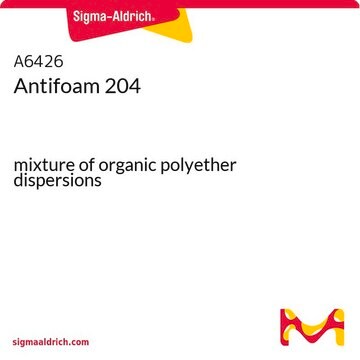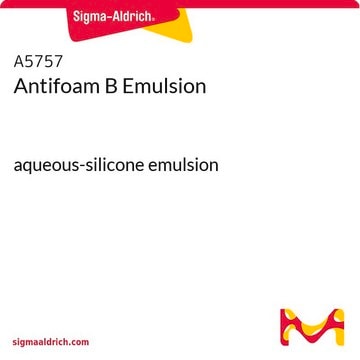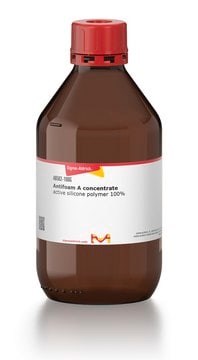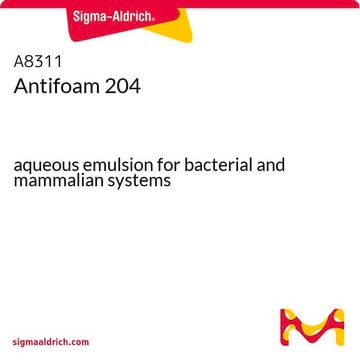The particle size of this product is not determined. However, silicon-based antifoam formulations have a general particle size range of 10um - 40um.
A8011
Antifoam C Emulsion
aqueous-silicone emulsion
Sinônimo(s):
Antifoaming Agent Emulsion
About This Item
Produtos recomendados
fonte biológica
synthetic
Formulário
emulsion
contém
emulsifier
técnica(s)
cell culture | hybridoma: suitable
microbiological culture: suitable
pf
0 °C (32 °F)
Categorias relacionadas
Descrição geral
Aplicação
- as a supplement in RO-H2O and a chemically defined culture medium to determine volumetric mass transfer coefficient (kLa) of mammalian cell culture[2]
- as a component of feed medium[2],
- as a steam-sterilized antifoaming agent in a biocontroller for pH-stat fed-batch cultivations[3]
- as a supplement in fed batch medium to mimic the typical large-scale cultivation conditions[4]
Características e benefícios
- Minimizes compatibility issues with biological systems
- Highly effective defoamer at low concentrations
- Highly effective and versatile silicone defoamer
Outras notas
Palavra indicadora
Warning
Frases de perigo
Declarações de precaução
Classificações de perigo
Eye Irrit. 2 - STOT SE 3
Órgãos-alvo
Respiratory system
Código de classe de armazenamento
10 - Combustible liquids
Classe de risco de água (WGK)
WGK 3
Ponto de fulgor (°F)
Not applicable
Ponto de fulgor (°C)
Not applicable
Equipamento de proteção individual
Eyeshields, Gloves, type ABEK (EN14387) respirator filter
Escolha uma das versões mais recentes:
Certificados de análise (COA)
Não está vendo a versão correta?
Se precisar de uma versão específica, você pode procurar um certificado específico pelo número do lote ou da remessa.
Já possui este produto?
Encontre a documentação dos produtos que você adquiriu recentemente na biblioteca de documentos.
Os clientes também visualizaram
-
What is the particle size range of the silicone emulsion particles in this anti-foam. Thank you!
1 answer-
Helpful?
-
-
How can I determine the shelf life / expiration / retest date of this product?
1 answer-
If this product has an expiration or retest date, it will be shown on the Certificate of Analysis (COA, CofA). If there is no retest or expiration date listed on the product's COA, we do not have suitable stability data to determine a shelf life. For these products, the only date on the COA will be the release date; a retest, expiration, or use-by-date will not be displayed.
For all products, we recommend handling per defined conditions as printed in our product literature and website product descriptions. We recommend that products should be routinely inspected by customers to ensure they perform as expected.
For products without retest or expiration dates, our standard warranty of 1 year from the date of shipment is applicable.
For more information, please refer to the Product Dating Information document: https://www.sigmaaldrich.com/deepweb/assets/sigmaaldrich/marketing/global/documents/449/386/product-dating-information-mk.pdfHelpful?
-
-
How is shipping temperature determined? And how is it related to the product storage temperature?
1 answer-
Products may be shipped at a different temperature than the recommended long-term storage temperature. If the product quality is sensitive to short-term exposure to conditions other than the recommended long-term storage, it will be shipped on wet or dry-ice. If the product quality is NOT affected by short-term exposure to conditions other than the recommended long-term storage, it will be shipped at ambient temperature. As shipping routes are configured for minimum transit times, shipping at ambient temperature helps control shipping costs for our customers. For more information, please refer to the Storage and Transport Conditions document: https://www.sigmaaldrich.com/deepweb/assets/sigmaaldrich/marketing/global/documents/316/622/storage-transport-conditions-mk.pdf
Helpful?
-
-
Will there be a problem if I add 100ppm of antifoam when cultivating bacteria?
1 answer-
This product is typically effective at 1-10 ppm. Therefore, there is no guarantee how 100 ppm will perform for bacteria cultivation.
Helpful?
-
-
Can the antifoam be autoclaved pure? When diluted (e.g. to 0.5% or 0.1%)?
1 answer-
Yes, this product may be autoclaved. Autoclaving the pure product may result in phase separation and might require remixing the emulsion.
Helpful?
-
Active Filters
Nossa equipe de cientistas tem experiência em todas as áreas de pesquisa, incluindo Life Sciences, ciência de materiais, síntese química, cromatografia, química analítica e muitas outras.
Entre em contato com a assistência técnica












